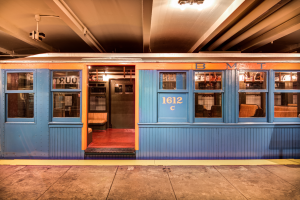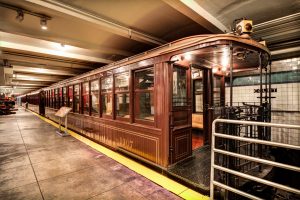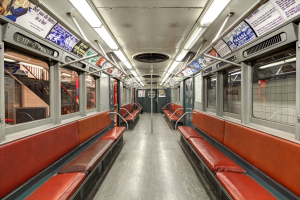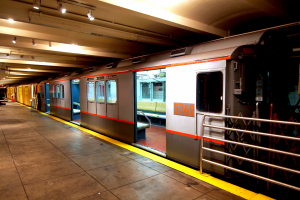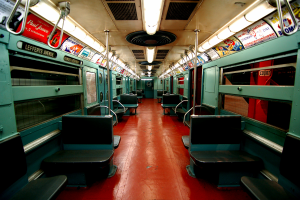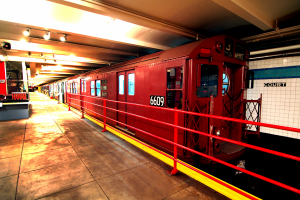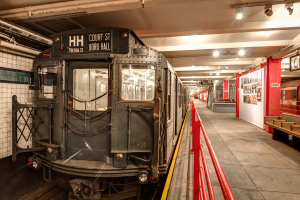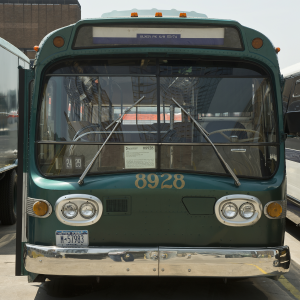Vintage Cars
BMT Q Car Number 1612C (1908, rebuilt 1938)
Car Manufacturer: Jewett Car Company (Newark, Ohio), 1908
Service: 1908-1969
Routes: Brooklyn elevated lines, 1908-1923; Astoria and Flushing lines, 1923-1949; Third Avenue Elevated, Manhattan, 1950-1955; Myrtle Avenue Elevated, Brooklyn, 1957-1969
City officials never considered wooden cars safe for subway tunnel operation and removed them from underground service after a 1918 accident involving wooden cars at Malbone Street, Brooklyn, killed 93 passengers. But more than 2000 open-platform elevated cars, such as 1612C (originally BRT car 1417), remained in use on elevated lines, which could not support the weight of new all-steel subway cars. In 1938 Car 1417 was rebuilt (and renumbered 1612C) to run with 1612A and 1612B; cars A and C were motorized, while car B was a trailer. Under the Dual Contracts, the IRT and BRT jointly operated new elevated sections, such as the Astoria (R) and Flushing (7) lines.
As the city prepared for the 1939 World’s Fair in Flushing Meadows, Queens, the BMT faced a quandary. The company was not content to use outdated cars to take passengers to a fair dubbed “The World of Tomorrow,” but was unwilling to spend money on new cars that could be used only on IRT-width lines. Instead, the BMT compromised by rebuilding 90 open-platform cars, including 1612C, into closed vehicles and repainting the cars in the World Fair’s official blue and orange color scheme. The resulting cars were used on the Myrtle Avenue Elevated line (built in 1888) until 1969–providing 60 years of service in Manhattan, Brooklyn, and Queens. They were the last wooden elevated cars to run in North America.
BRT Brooklyn Union Elevated Car Number 1407 (1907)
Car Manufacturer: Jewett Car Company (Newark, Ohio), 1907
Service: 1908-1969
Routes: Brooklyn elevated lines, 1908-1938; as Q Car on Astoria and Flushing lines, 1939-1949; Third Avenue Elevated, Manhattan, 1950-1955
In 1907 the BRT ordered 100 cars similar to car number 1407, which was typical of the self-propelled cars ordered after the BRT electrified its elevated lines in 1900. Steam engines pulled elevated trains before 1900. Despite electrification, the car design remained the same–lightweight wooden body coaches (mounted on steel underframes) that passengers entered and exited via open-air vestibules at each end. A conductor manually opened and closed the gates and rang a ceiling-mounted bell when passengers were safely on board to signal the motorman to proceed.
This car, along with the other Brooklyn Union cars in the collection, had a surprisingly long career. After 30 years of service on Brooklyn elevated lines the cars were modernized into Q cars (1407 was renumbered 1622C) and placed into service on the Flushing line (today’s 7 train), where they carried passengers to and from the 1939 World’s Fair. They were refitted with side doors and painted in the World’s Fair blue and orange color scheme. The Coney Island Overhaul Shop restored car 1407 to its original appearance in 1979. The Brooklyn Union cars are the oldest passenger vehicles in the New York Transit Museum’s collection.
IRT R-15 Car Number 6239 (1950)
Manufacturer: American Car and Foundry Company (Berwick, Pennsylvania), 1950
Service: 1950-1985
Routes: Flushing line (7), 1950-1964; IRT lines (Numbers 1/9, 2, 3, 4, 5, 6), 1964-1985
Innovations in the subway system after World War II, including R-15 cars, continued even as increasing numbers of city residents moved to the suburbs and used automobiles for commuting. The R-15 order was small but significant. Although only 100 cars were produced, they combined the best features of other post-war orders with new and experimental features. The cars contained the propulsion and braking system of R-10 cars with design features of the R-11. The cars arrived painted a distinctive maroon with beige stripes. Porthole window design was adapted from earlier R-11cars.
This R-15 car, number 6239, is notable as the first car in the New York City subway system to be air-conditioned. The air-conditioning was installed 5 years after the car was put into service, but it failed after only 2 weeks of operation in the dusty subway environment. The cars were often damp, and water dripped on passengers. The costly and ineffectual air-conditioning was removed, but the New York City Transit Authority continued to work on the technology.
IRT R-12 Car Number 5760 (1948)
Manufacturer: American Car and Foundry Company (Berwick, Pennsylvania), 1948
Service: 1948-1985
Routes: IRT Flushing line (7), 1948-1964; other IRT lines (Numbers 1/9, 2, 3, 4, 5, 6) and Third Avenue Elevated, Bronx, 1964-1985
World War II halted the production of new subway cars and by 1945 cars were in short supply throughout the system. Thus, the arrival of 10 R-12 cars was celebrated as they were shuttled across the East River on a barge from the Hoboken rail terminal in 1948. The barge flew banners proclaiming, “New Yorkers, Look. Your New Subway Cars” and a city fireboat sent out a dozen streams of water.
Built concurrently with the R-10, R-12s had the same type of propulsion, braking, ventilation, and window design. The R-12 cars contained 44 seats and introduced new features to IRT cars, such as double doors to expedite the loading and unloading of passengers. For standing passengers, grab handles were eliminated in favor of poles. Despite these design innovations, overcrowding remained an issue. A New York Times editorial suggested that a rich post-Depression diet and full post-war employment were adding to the problem, “With more and stouter people about us it is only a matter of time before the [subway] car must explode.”
R-11 Prototype / R-34 Car Number 8013 (1949)
Manufacturer: Budd Company (Philadelphia, Pennsylvania), 1949
Service: 1949-1976
Routes: BMT 14th Street Canarsie line (L), the Jamaica, West End line (B), and Franklin Avenue Shuttle (S), 1949-1964, 1965-1976
In anticipation of the construction of the Second Avenue subway, the city ordered 10 trial R-11 cars. When a model of the car— equipped with a host of innovations and stainless steel construction—was unveiled to the press The New York Times described it as “The car of tomorrow.” Because of the $100,000 price tag for each car, the R-11 was also called “The Million Dollar Train.” Unfortunately, the “car of tomorrow” never went into full service operation and additional R-11 cars were never ordered. Because the cars could not be readily used with other R types, they were rebuilt to be compatible with existing cars under contract R-34 in 1964-1965. With the mechanicals and interior standardized, only the unique exterior of the cars remained the same (except for some minor changes to the doors).
With its shot-welded stainless-steel body construction and porthole windows, the R-11 car looked thoroughly modern. New features included a public address system and crank operated windows. An air filtration system equipped with electrostatic dust filters and ultraviolet germ-killing lamps were installed. Exposed fans and ventilators were eliminated. The city hoped these measures would help curb the spread of air-born diseases and improve public health.
The fluorescent lighting used in the R-11 cars proved to be less than reliable at first. One rider commented in a letter to a newspaper editor that while “a wonderful improvement…it has a penchant to go blind. No provision has been made to enable trainmen to replace quickly burnt-out sections and therefore many cars run in a dimout.”
IRT R-17 Car Number 6609 (1955)
Manufacturer: St. Louis Car Company (St. Louis, Missouri), 1955 (additional fleet vehicles, 1956)
Service: 1955-1986
Routes: IRT Lexington Avenue/Pelham line (6), 1955-1986; Times Square Shuttle (S) 1955-1960; IRT lines (1/9, 2, 3, 4, 5, 6) 1960-1986; Flushing line (7), 1962-1964 and 1984
In the 1950s the Transit Authority turned its attention to improving IRT rolling stock. Car number 6609 was one of 400 R-17 cars that were put into operation beginning in 1955. Nearly identical to the R-16 models placed in service on the BMT division the year before, the R-17 was an economical purchase–the interchangeability of parts saved greatly on repair and maintenance. The R-17 represented a first in car seat design, as rattan and velon seat covers were abandoned in favor of foam-filled, red plastic bench cushions. Two later series of cars, R-21 and R-22, were designed and manufactured to specifications nearly identical to the R-17. These “sister car classes” added 1,100 cars to the system.
Efforts to air-condition subway cars continued with 10 R-17 test cars (6800-6809). In summer 1956 an air-conditioned test train ran on the Lexington Avenue, Seventh Avenue, and Times Square Shuttle lines. These failed. More powerful units were installed the following summer, with only limited improvement. The experiment, described by The New York Times as “a fraud compounded of good intentions” and “a new, cruel and unusual punishment,” was abandoned on the R-17 cars in 1962. The mechanical failure was blamed on high relative humidity during rush hours that created excessive moisture in the air. The Transit Authority installed conventional fans in the cars, but vowed to continue to experiment with air-conditioning.
IND R-1 ‘City-Car’ Number 100 (1930)
Manufacturer: American Car and Foundry Company (Berwick, Pennsylvania), 1930
Service: 1931-1970
Routes: BMT Sea Beach line (N), 1931; IND Eighth Avenue lines (A,C,E), Sixth Avenue lines (B,D,F), and Crosstown line (G), 1932-1970
When the Independent Subway System (IND) opened its Eighth Avenue line in 1932, newly designed rolling stock went into service. The series was called R-1 because the cars were ordered under contract R-1, or Revenue Contract 1, and all subsequent cars ordered by the city were given an “R” designation followed by a series number. Car 100 was the first of the 300 cars in the R-1 series to be delivered to New York City.
The R-1 car combined the best feature of IRT cars (speed) with the best of the BMT (large passenger capacity). The R-1 cars’ most notable innovation was the 4 sets of double doors on each side to allow for faster loading and unloading of passengers. Devices making it impossible for passengers to hold doors open were also new and expected to further cut loading time and reduce passenger injuries. Each 60-foot-long car contained 60 seats in a mixed pattern of cross and lengthwise seating, and room for a total of 280 passengers. Cars built for the IND throughout the 1930s (R-1 through R-9) retained the same basic design and mechanical systems.
The R-1’s riveted shell and utilitarian green paint epitomized the somber, industrial look of the Depression years. Yet the train also inspired a classic swing number, composer Billy Strayhorn’s “Take the A Train.”
Vintage Buses
 Bus Number 3100 (1956) was the first air-conditioned bus in the United States used for public transportation. The bus was designed and built as an experiment, and this single example was purchased by the Fifth Avenue Coach Company about a year after its manufacture. It has other features first introduced in the 1950s: a push‑type rear exit door, wrap-around seating in the rear portion, soft seating, and fluorescent lighting. After two decades of passenger service, this vehicle was assigned to the Transit Police; it was retired from all service in the mid-1970s.
Bus Number 3100 (1956) was the first air-conditioned bus in the United States used for public transportation. The bus was designed and built as an experiment, and this single example was purchased by the Fifth Avenue Coach Company about a year after its manufacture. It has other features first introduced in the 1950s: a push‑type rear exit door, wrap-around seating in the rear portion, soft seating, and fluorescent lighting. After two decades of passenger service, this vehicle was assigned to the Transit Police; it was retired from all service in the mid-1970s.
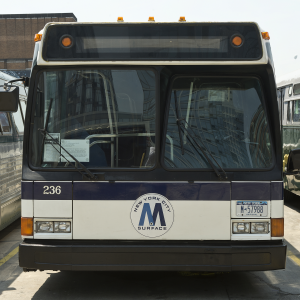 Bus No.236 (1980) was one of a new generation of buses called “Advanced Design” vehicles, equipped with wheelchair lifts and electronic destination signs. In 1980, this fleet of 850 was in service throughout the city; No. 236 was assigned to the East New York Depot. Despite its technological advancements serious structural problems were soon discovered. In a dramatic move that became citywide news, the entire fleet was retired overnight in February 1984.
Bus No.236 (1980) was one of a new generation of buses called “Advanced Design” vehicles, equipped with wheelchair lifts and electronic destination signs. In 1980, this fleet of 850 was in service throughout the city; No. 236 was assigned to the East New York Depot. Despite its technological advancements serious structural problems were soon discovered. In a dramatic move that became citywide news, the entire fleet was retired overnight in February 1984.
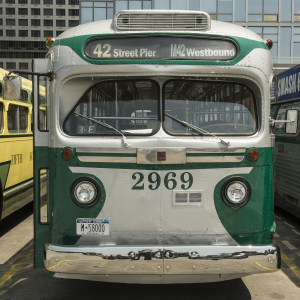 Bus Number 2969 (1948), one of the first 40-foot transit buses, was designed specifically for New York City. It features a double-width front door to expedite passenger loading and unloading. Known as the “Jackie Gleason Bus,” it was originally bus 4789, but was renumbered to match the bus that the comedian was photographed in as Ralph Kramden in the classic television series “The Honeymooners.”
Bus Number 2969 (1948), one of the first 40-foot transit buses, was designed specifically for New York City. It features a double-width front door to expedite passenger loading and unloading. Known as the “Jackie Gleason Bus,” it was originally bus 4789, but was renumbered to match the bus that the comedian was photographed in as Ralph Kramden in the classic television series “The Honeymooners.”
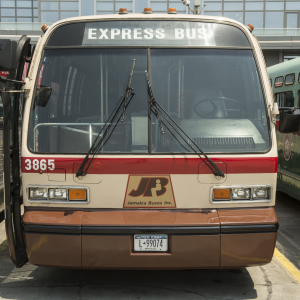 Bus Number 3865 (1993) was originally delivered to Queens Surface Corporation for service on its routes out of what is now MTA Bus Company’s College Point Depot. In May 2000, Bus 3865 and 11 other TMC RTS buses were transferred to Jamaica Buses Inc., to replace the last of the 1980 Grumman Model 870s that Jamaica Buses was still running. Jamaica Buses was established in 1933, as a subsidiary of the company operating electric streetcars in Queens since the late 1890s. After more than 70 years of service, Jamaica Buses was taken over by MTA Bus Company on June 30, 2006. Its depot was renamed Baisley Park Depot.
Bus Number 3865 (1993) was originally delivered to Queens Surface Corporation for service on its routes out of what is now MTA Bus Company’s College Point Depot. In May 2000, Bus 3865 and 11 other TMC RTS buses were transferred to Jamaica Buses Inc., to replace the last of the 1980 Grumman Model 870s that Jamaica Buses was still running. Jamaica Buses was established in 1933, as a subsidiary of the company operating electric streetcars in Queens since the late 1890s. After more than 70 years of service, Jamaica Buses was taken over by MTA Bus Company on June 30, 2006. Its depot was renamed Baisley Park Depot.
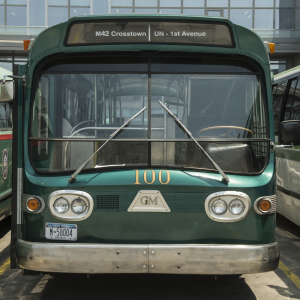 Bus Number 100 (1959) was among the first group of 190 buses that introduced the “New Look” or “Fishbowl” style to New York City. Developed by GMC, the “New Look” design — featuring the large bubble-shaped windshield, single-piece destination sign, and parallelogram windows — prevailed for twenty years, until the boxier “Advanced Design” bus style was introduced in 1980.
Bus Number 100 (1959) was among the first group of 190 buses that introduced the “New Look” or “Fishbowl” style to New York City. Developed by GMC, the “New Look” design — featuring the large bubble-shaped windshield, single-piece destination sign, and parallelogram windows — prevailed for twenty years, until the boxier “Advanced Design” bus style was introduced in 1980.
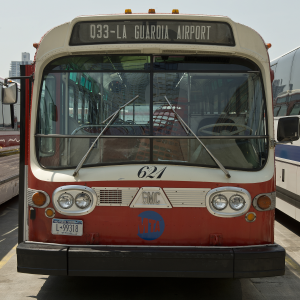 Bus Number 621 (1979) was one of 10 new “Fishbowl” buses purchased from the Diesel Division of General Motors of Canada, Ltd., in 1979. Used in both express and local service, these buses were retired in the 1990s. Bus No. 621 was restored in the bright red and silver color scheme with numbers and lettering in the company’s then new font style. Triboro Coach was taken over by MTA Bus Company on February 20, 2006.
Bus Number 621 (1979) was one of 10 new “Fishbowl” buses purchased from the Diesel Division of General Motors of Canada, Ltd., in 1979. Used in both express and local service, these buses were retired in the 1990s. Bus No. 621 was restored in the bright red and silver color scheme with numbers and lettering in the company’s then new font style. Triboro Coach was taken over by MTA Bus Company on February 20, 2006.
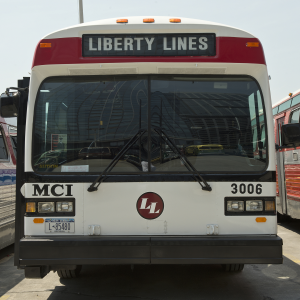 Bus Number 3006 (1988) is one of the “Classic” design model buses made for Liberty Lines Express. The “Classic” was introduced by General Motors of Canada in 1982 to replace the “New Look” bus design. Bus 3006 was retired in early 2006 with more than 500,000 miles.
Bus Number 3006 (1988) is one of the “Classic” design model buses made for Liberty Lines Express. The “Classic” was introduced by General Motors of Canada in 1982 to replace the “New Look” bus design. Bus 3006 was retired in early 2006 with more than 500,000 miles.
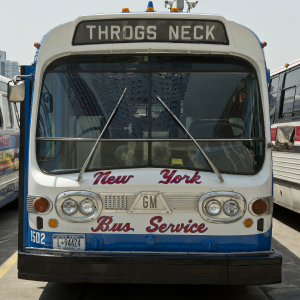 Bus Number 1502 (1982) was one of 25 “New Look” buses made for New York Bus Service in 1981. These were designed and equipped with “suburban” bus features – forward-facing seats on platforms, parcel racks, reading lights, and a single door, though without baggage compartments or reclining seats. On July 1, 2005, New York Bus Service was taken over by the MTA Bus Company, a new agency created to consolidate the operations of seven private bus lines under franchises from the City of New York.
Bus Number 1502 (1982) was one of 25 “New Look” buses made for New York Bus Service in 1981. These were designed and equipped with “suburban” bus features – forward-facing seats on platforms, parcel racks, reading lights, and a single door, though without baggage compartments or reclining seats. On July 1, 2005, New York Bus Service was taken over by the MTA Bus Company, a new agency created to consolidate the operations of seven private bus lines under franchises from the City of New York.
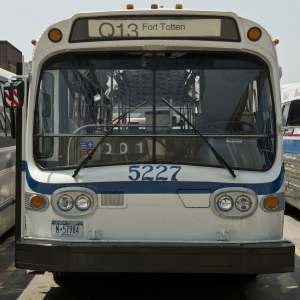 Bus Number 5227 (1971, rebuilt 1985)
Bus Number 5227 (1971, rebuilt 1985)
In 1984-1985, 350 GM “New Look” buses from the NYC Transit fleet were sent to the Blitz Corporation of Chicago for complete overhaul and rebuilding. When they were returned to New York, renumbered in the “5000-series,” they were known as “Blitz Buses.” The buses featured hard, blue lengthwise seating. Bus 5227 was the last bus not equipped with a wheel-chair lift to operate for NYC Transit.
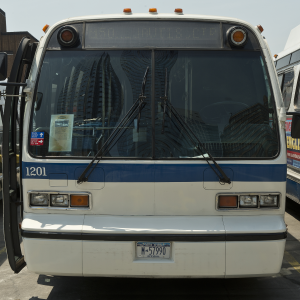 Bus Number 1201 (1981) was one of the first order of 837 RTS (Rapid Transit Series) model buses, purchased in 1981. A total of 4,877 RTS buses, built by three different manufacturers, were eventually ordered for NYC Transit and MaBSTOA service between 1981 and 1999. All these buses were equipped with wheelchair lifts, enabling NYC Transit to become the first large public transit agency to have a 100% accessible fleet.
Bus Number 1201 (1981) was one of the first order of 837 RTS (Rapid Transit Series) model buses, purchased in 1981. A total of 4,877 RTS buses, built by three different manufacturers, were eventually ordered for NYC Transit and MaBSTOA service between 1981 and 1999. All these buses were equipped with wheelchair lifts, enabling NYC Transit to become the first large public transit agency to have a 100% accessible fleet.
New York City Transit purchased 133 buses of this type to begin replacing the 1956-vintage Mack C-49 fleet. Thirteen of the new buses, all equipped with 47 high-back, front facing, upholstered seats, were built for the new Staten Island-to-Manhattan express service, which debuted in December 1968. Later, this model modified with luggage racks, was used for the connecting JFK Express bus service.


